2014 Harley-Davidson Street Glide Special Vs. Indian Chieftain – Video

Old competitors on a new battlefield
Rivalry (ˈrīvəlrē) n., Competition for the same objective or for superiority in the same field.
In the early days of motorcycling, Indian and Harley-Davidson began a decades-long battle. The first Indian motorcycle was created in 1901 while the first Harley-Davidson was born in 1903. Somewhere down the road an intense rivalry developed. Insults went from good natured to downright nasty. Owners of one brand wouldn’t associate with owners of the other.
However, rivalries can be a force for good, a creator of tradition and ritual, a motivating force. Manufacturers embroiled in a heated competition regard each other as an opportunity to hone their industrial might. They use their enemy to push themselves to innovate and improve. The benefactor is ultimately you, the consumer.
Unfortunately for motorcyclists, the production of Indians ceased in 1954. Harley-Davidson won. Since then, many have hoped that the old marque could be reborn, and the last 20 years have been especially convoluted as various parties fought over the right to use the Indian name. Although bikes running Harley clone engines and, later, proprietary engines have worn the Indian logo in recent years, the acquisition of the name by Polaris was the best thing to happen to Indian in a long time.
View the gallery for more photos
During the last two decades, while the Indian name was so abused, Polaris successfully created, launched, and turned a profit with an all-new American motorcycle brand. However, Victory would have a hard time directly challenging The Motor Company since Harley has the weight of history behind it. So, Polaris, a formidable motorsports company in its own right, has brought Indian back from the dead to take another stand against Harley-Davidson.
Setting the Stage
Both the Indian Chieftain and the Harley-Davidson Street Glide Special come packed with premium features. The Special is $2600 more than the standard Street Glide model and bundles the most popular optional components. In addition to the Special designation, our Street Glide test unit’s Sand Cammo Denim color costs extra. The Chieftain, on the other hand, is the California model with the extra-cost red paint. This leaves us with two bikes with as-tested MSRPs separated by only $740 ($490 if you take off the Indian’s California-specific costs).
The $23,749 ($23,499 49-state) Indian Chieftain has a style that clearly weighs in on the side of forging a link to the company’s past with modern interpretive touches. Looking at the Indian’s deeply skirted fenders with the illuminated War Bonnet on the prow, it’s almost possible to believe it wasn’t manufactured many decades ago. That is until you notice details like the pickups for the ABS or the LED brake light and turn signals.
The fork mounted fairing – a first for an Indian of any era – has the classic Batwing shape. However, the LED turn signals and even the lines of the fairing itself are clearly influenced by modern esthetics. Look on the inside of the fairing, and you’ll find premium standard features, like ABS, cruise control, and a 100W stereo with both wired and wireless connections to your personal electronics.
The $23,009 Harley-Davidson, without the handicap of the multi-decade halt of production and the ownership merry-go-round of Indian, only needs to be exactly what it already is: the “fully loaded” update of the best-selling motorcycle model in the United States. While its appearance was altered slightly as part of Project Rushmore, the bike’s lines remain essentially the same. The most dramatic visual change is the longer nose to the fairing.
In addition to the updated shape, the Batwing fairing received a vent behind the shorty windscreen to help reduce the rider’s head buffeting at elevated speeds. As part of the Special package, the fairing has a glossy black interior and a feature-laden stereo/navigation system.
REVIEW: 2014 Harley-Davidson Touring Models
Another big Project Rushmore change comes in the form of revised saddlebag lids and locks. Although, when seen in profile, the bags look unchanged, the new lock transforms the bags from a nuisance to a much more usable feature.
Engines
The Street Glide Special features a Project Rushmore High Output Twin Cam 103 powerplant – an upgrade but not the new liquid-cooled engine. While the 98.4mm x 111.1mm cylinders of the Twin Cam engine remained unchanged, an updated camshaft and a better flowing airbox were added to deliver improved bottom end power. Our seat-of-the-pants impression of the HO Twin Cam 103 was that engineers achieved their goal. However, the redesigned airbox isn’t just about power, it also gives the rider more legroom and redirects airflow around the cockpit.
The rider was the primary consideration when the hydraulic clutch was updated. Despite heavier clutch springs on the 2014 models, lever effort is the same as the pre-Rushmore engine. The hydraulic clutch also eliminates the need for periodic adjustment.
The Indian’s Thunder Stroke 111 49-degree V-Twin, courtesy of the 101mm x 113mm cylinders and the single-pin crankshaft, produces the pulse pattern that riders in this class of motorcycle demand. The Thunder Stroke 111 straddles the line of maintaining the Indian’s historic lines while performing as a completely modern engine. The engine’s bulbous cooling fins take advantage of the extra space at the top of the 49 degree V to gain more cooling capacity while remaining true to the engine’s visual roots. The hydraulically operated valves eliminate valve adjustment while maintaining the classic pushrod design.
Since the Indian displaces eight cubic inches more than the Harley, we’d expect it to have some kind of performance advantage. While the Chieftain never felt underpowered, it surprisingly felt a little short on oomph when ridden in conjunction with the Street Glide.
The Thunder Stroke delivered massive torque almost off idle – although having an absurdly immediate clutch engagement made it more of a challenge to get the most out of that initial grunt. Once under way, the Chieftain had a clear low-end power advantage – with the dyno charts revealing a whopping 33% difference in torque at 1900 rpm. Although the Thunder Stroke never surrenders the torque advantage, the HO Twin Cam 103 whittles it down to 11 percent at their peaks of 102.83 ft. lb. and 92.07 ft. lb., respectively. Still, the Thunder Stroke produces a stronger torque curve up to its peak torque at 3100 rpm. However, the TS’ torque falls off more quickly than the Twin Cam’s flatter curve after maximum output.
Horsepower follows a similar path with the Indian producing more horsepower at the lower rpm and carrying that lead to a lessening degree up to its peak of 74.24 hp at which point, the Harley matches it horse for horse – then keeps going on to a 77.04 hp maximum. If you think that the Thunder Stroke’s eight cubic inch displacement advantage would translate into more horsepower, you’d be wrong.
However, the dyno numbers don’t adequately reveal the difference in these two engines. The HO Twin Cam is more responsive and revs quicker than the Thunder Stroke. This is not to say that the TS feels like it lacks power, but the Harley’s engine always feels raring to go, eagerly awaiting that next twist of the throttle. Although the term perky may sound odd in the context of large displacement V-Twin engines, the word applies in the case of the Street Glide.
“While dyno figures see the H-D with more horsepower and the Indian with more torque,” observes Content Editor, Tom Roderick, “in the real world the Project Rushmore 103 engine delivered more immediate response to throttle inputs and was an overall more willing powerplant.”
The Chieftain’s extra weight, about 40 pounds, plays a role in blunting its power and hindering its low-speed acceleration. Conversely, the Indian’s torquier mill gives it an advantage in top-gear roll-on contests, motoring away from the revvier Harley.
Power delivery isn’t the only measure of these bikes’ performance. Fuel economy and, consequently, range are very important in the touring market. The Street Glide delivered an average of 36.5 mpg to the Chieftain’s 32.3 mpg. These, in turn, point to a calculated range of 219 miles for the Harley while the Indian could reach 178 miles, representing a significant difference for bikes designed to embark on tank-draining stints.
Our two contestants score a tie in the vibration department with neither delivering significant buzzing to the rider at a variety of speeds. The only noticeable difference is that the Chieftain’s bar-mounted mirrors had slightly more blur at highway speeds than the Street Glide’s fairing-mounted ones.
Finally, we believe both bikes could use a little refinement in their stout-sounding transmissions. Each shift is punctuated by a resounding thunk – with the Chieftain’s being slightly louder. We think that motorcycles in this price range deserve gearboxes that don’t sound like crude tools. The shifting effort is similar on both bikes (although the Indian lacks a heel shifter that many riders prefer with floorboards). Since we know that bikes making big horsepower can shift quietly, we wonder why these two machines don’t have 21st century transmissions.
Once the numbers are crunched, the engine advantage goes to the Street Glide Special.
Chassis
No area of these two motorcycles generated more debate than the suspension. However, most of the heat of these discussions was directed toward Harley’s self-imposed limits to rear suspension functionality because of the Street Glide’s shocks’ mere 2.1 inches of travel. The equation is simple; on any motorcycle – but particularly on these big, heavy motorcycles – the shock with half the travel of the other will have a more difficult time taking the hits out of road irregularities. Even with the easy, knob adjustable preload, the Special’s shocks come up short (pun intended) in every riding situation that doesn’t involve smooth pavement.
Within the constraints of the suspension travel, the Street Glide Special does a pretty good job of fending off the slings and arrows of outrageous pavement. However, we believe the suspension of a touring bike should have more than two inches of travel. Our time aboard these bikes was limited to California roads unscathed by frost heaves, so the limited suspension movement wasn’t a major issue. But feeling every ripple of pavement in the glutes will not increase the rider’s enjoyment of long days in the saddle. The bumpier the roads, the more you’ll suffer on the SGL.
The rest of the Street Glide Special’s manners were impeccable. The new, beefier fork is well sorted and shows the attention it received as part of Project Rushmore. Turn in and changing lines mid-corner were much easier than you’d expect from such a big bike. At speed, the Special feels much smaller than its 64-inch wheelbase and 810-pound specifications. In short, the Street Glide Special feels willing and eager to turn when you want to turn it. When asked to lean over far enough to touch down the floorboards, the Harley does so cleanly at a respectable angle for a cruiser.
Where the Street Glide is eager, the word that best describes the Chieftain is stable. Turning in requires slightly more effort – even with its wider handlebar. Changing lines is similar, requiring a little more effort but accomplished quite easily. Despite the use of an aluminum frame, Indian claims an 848-pound weight with its tank full, 38 pounds more than Harley’s claim for the SGL. The Indian’s stylish but massive valanced fenders surely add mass.
Where the Harley felt smaller than its heft, the Indian felt balanced. We never confused the bike for being less than its 65.7-inch wheelbase, but that is not a bad thing. When dragging floorboards, the Indian touched down sooner and had a smaller margin before grinding solidly mounted parts.
On undulating pavement, the Chieftain was unflappable. The suspension soaked up most of the pavement irregularities, only letting the hard, sharp-edged bumps directly affect the rider. On interstates, where the expansion joints had the Harley hobby-horsing and transmitting the jolts directly to the rider’s hind parts, the Indian’s single air-adjustable shock felt like it was still on the boulevard.
Hauling these big bikes down from speed produced another clear divide between this pair. The Indian’s brakes got the job done, although the front brake required more effort than we would like. Since the level of effort was high and the feedback was wooden, we figure that the Chieftain suffers from a poor pad compound choice by the factory. The ABS works exactly as it should, unobtrusively interceding when wheel lockup approached.
The Special, with its Rushmore-derived Reflex Linked ABS Brakes, uses electronics to assist the rider in the widely varying braking conditions. At speeds above 20–25 mph the linked braking system modulates the power distribution of the front and rear brakes. If you only hit one brake, the other will also engage. If you over- or under-use one of the brakes, the system will attempt to bring the ratio back into balance. Below the low-speed threshold, the system maintains the front and rear brake separation, making it easier to maneuver the bike at low speed.
The constantly adjusting nature of the Reflex system makes it very unobtrusive compared to many other linked systems. Still, experienced riders will notice that some of their single brake techniques cannot be used. The efficacy of the Special’s brakes was no doubt influenced by how well sorted the Reflex system was. Roderick commented that the Harley generated more braking force with less pressure. All riders noted how much more powerful the Special’s brakes were compared to the Chieftains.
The winners of the chassis and braking categories are: Chieftain and Street Glide, respectively.
Rider/Passenger Accommodations
Both of these bikes have chosen a fork-mounted Batwing fairing to ease a rider’s path through the air. The Indian steps in with an electrically adjustable windshield to help the rider tune the character of the wind that is allowed into the cockpit. The Chieftain’s windshield in its tallest position blocks the most of the air’s onslaught, giving the rider a calm pocket in the saddle.
While this gives the most protection in cold weather, the rider is forced to look through the windshield. However, the infinite adjustability allows the rider find the right compromise of weather protection and visibility – especially in light rain which builds up on the screen, making it almost impossible to see. In its lowest position, the wind flows easily over the helmet of riders in the neighborhood of six feet with minimal buffeting. Any turbulence encountered by riders can be tuned out with small screen height adjustments.
The Harley’s fairing features a short tinted windshield that riders of average height can easily see over. The new vent in the fairing just below the shield reduces some the turbulence created by the windshield – although the effect varies with rider height. Taller windshield options are available as factory accessories.
The riding positions of these touring twins are slightly different. The Harley plants the rider’s upper body in a more upright riding position while the Indian’s slightly laid-back position borders on the “cruiser slouch.” Our testers were divided on the riding position with Roderick giving the nod to the Special and myself preferring the Chieftain.
The rider portions of the saddles were well-shaped for the long haul. Both were wide enough to allow some wiggle room, though the Harley’s shape tended to center the rider’s butt a bit. Roderick commented that he wished the Harley’s seat rose up a little more in the rear to increase the lower back support.
The passenger accommodations were a different story. The Chieftain’s broad, flat pillion presented the passenger with a nice place to while away the miles. The narrow, rearward-sloping Street Glide pillion? Not so much.
Engine heat on the Indian was a surprising issue. The test days were not particularly hot, but during lower speed travel and stop-and-go traffic, the rider and passenger’s right thighs got pretty toasty.
Even with the thigh warmer, the accommodations category goes to the Chieftain.
Carrying Capacity
Baggers, especially those with locking hard bags, are all about the convenience of carrying gear. Locking and weatherproof sealing are expected in this class of motorcycle.
While the Street Glide’s bags may look pretty dang similar to the pre-Rushmore versions, their utility has improved immensely through the addition of a new locking mechanism. The old method of opening a bag involved lifting the latch on the outside of the bag which, in turn, raised the outside edge of the lid. Next, the lid was removed by sliding it sideways and flipping it over, towards the latch which was actually the hinge. Although opening the bag was relatively easy – once you knew the trick – closing the bag could get a little fidgety, requiring two hands, as the lid was lined up with the attachment points.
The new, much simpler bags use a latch on the forward inside corner of the bag. Lift it up and the lid pivots open on the hinge, looking like the old-style hinge/lock. Closing the bag requires a positive locking move of pressing the latch down. This brings up two schools of thought on bag closure: Some riders like to slam their bags closed, determining they’ve latched by the sound, but others like to press their bags closed to be positive of a secure seal. The Street Glide’s bags will not latch for you bag-slammer types. Rather, you close the lid and press down on the latch’s lever which tells the rider, tactilely, when the bag is locked.
The Chieftain, despite its uber-retro styling, took a high-tech approach to the hard bags. First, the bag locks are electric and can be unlocked with either the bike’s key fob or a button on the tank. If you prefer an analog mode of unlocking your saddlebags, you can always use the steering lock key. The bag opens via a button located in the center of the lid. Like the Harley, the lid pivots outward, giving maximum access to the interior. One plus for the Indian is the cigarette lighter plug in the right saddlebag for charging your personal electronics.
The saddlebags on both bikes are easily removable. The Street Glide’s bags come off with the twist of a couple Dzus quarter-turn fasteners. The Chieftain’s bags would be even easier if not for one exception. The bags are held in place by a pair of expanding rubber fasteners. An interference fit with a pair of billet aluminum cylinders on the Indian’s fender rails holds the bags in place when the levers inside the bags are flipped 90 degrees. A pair of electrical connectors behind the side panels slows down the Chieftain bag removal. Although the panels are only mounted with rubber grommets, the extra step takes a little time.
Neither bikes’ saddlebags offer any type of carrying handle (you’ll want to buy some accessory bag liners for transporting your clothes to your motel room), so removing the bags will largely be for access to the rear wheel for maintenance. Both bikes can be ridden without their bags, but the Chieftain looks far more finished – in fact, it looks quite similar to the Chief.
The final assessment of the bags is the capacity. The Street Glide’s saddlebags have a weight limit of 20 lb. and a volume of 16 gallons each. The Chieftain’s bags each can hold 22 lb. and 17.2 gal.
Chalk the luggage category up to the Indian.
Touring Extras
What would touring bikes be without electronic tools to help rack up the miles? Both the Chieftain and the Street Glide offer plenty of tools and entertainment options to keep a rider happy.
Both bikes offer cruise control that is operated from the handlebars. Unfortunately, our pre-production Chieftain had a non-functioning cruise control. We did get a chance to ride an Indian with a working cruise control, and it performed its duties with aplomb equal to the Street Glide’s system.
While both bikes offered infotainment systems that delivered just about everything that a rider could need – short of neck massages – the Street Glide with its Boom Box set the standard. Both stereo systems allowed Bluetooth and wired connections to and from personal electronics – including phones and headsets. The Harley’s dash featured dedicated storage with USB power and a holder to keep the device from bouncing around. The Indian, in an uncharacteristically, seemingly cobbled together approach, has a padded pouch hanging behind a door inside the fairing to hold the device while being charged. The Chieftain had the most information on the status of the motorcycle available at the flick of a pair of bar-mounted switches, but the tire pressure monitor did not work.
The stereos on both bikes have enough power to blast out the tunes over the wind and highway noise at speed. The dizzying number of options should keep even Iron Butters happy for weeks in the saddle. All of the functions on the Indian are accessed via buttons on the bar switch gear, and once learned are easy to operate at speed – although having large paws makes it easier.
The Street Glide has a plethora of switchgear buttons and toggles but could use some reworking to make it more user friendly. (Take a look at the BMW’s scroll wheel, for an example.) However, the Boom Box’s touch screen with GPS still steals the show. Being able to get turn-by-turn directions directly on the dash from a built-in unit is a deal changer. Roderick gushed, “The centrally mounted, full-color, touchscreen display with included GPS navigation has everything but an Xbox.”
Unfortunately, all is not perfect in H-D GPS-land. Every time you start the Street Glide, an annoying warning that must be manually dismissed comes up on the Boom Box screen. If you miss the verbal instructions, the on-screen information of an upcoming turn is limited to which direction to turn and what lane to do it from. On highways with multiple exits in short succession, this simply isn’t enough. Roderick concluded, “I have free mapping apps in my phone that provide better, earlier directional routing than does this system.” Still, a GPS that needs some refinement is better than no GPS at all.
The Street Glide Special with its Boom Box and GPS wins the infotainment war.
Summary
Well, the dust has settled on our first pairing of these old rivals, and the results are more than a little surprising. These bikes delivered the closest score of any MO shootout ever with only 0.75 points separating the competitors.
Indian Chieftain
| Engine | 16.5/20 |
| Suspension/Handling | 12.92/15 |
| Transmission/Clutch | 7.5/10 |
| Brakes | 8.25/10 |
| Instruments/Controls | 4/5 |
| Ergonomics/Comfort | 9/10 |
| Appearance/Quality | 9.13/10 |
| Desirability | 9.25/10 |
| Value | 6/10 |
| Overall Score | 82.55/100 |
Harley-Davidson Street Glide Special
| Engine | 17.5/20 |
| Suspension/Handling | 10.75/15 |
| Transmission/Clutch | 9/10 |
| Brakes | 9/10 |
| Instruments/Controls | 4.5/5 |
| Ergonomics/Comfort | 7.75/10 |
| Appearance/Quality | 9/10 |
| Desirability | 8.38/10 |
| Value | 5.92/10 |
| Overall Score | 81.8/100 |
Going into this comparison, we felt that, if the Chieftain finished close, it would be a victory of sorts. Instead, the Indian Chieftain squeezed by with a win.
Indian has managed to create a line of motorcycles in just 27 months – and produced a bagger that could go toe-to-toe with the best-selling motorcycle in the country. This bodes quite well for the Indian brand and riders alike. Although we’d like to see Harley address the shortcomings of the Street Glide, we don’t expect much to happen on the surface. When you’re on top, the last thing you want to do is give a new entry in your market the credibility of acknowledging it as competition. Indian has opened well, but no matter how well a single bike compares, it’s gonna need to stick around for a while before it gets more than a sidelong glance from Harley-Davidson – much less be considered a rival.
Harley-Davidson Street Glide Special
+ Highs
- Revvy, willing engine
- Responsive brakes
- Boom Box entertainment/GPS system
– Sighs
- Harsh rear suspension
- GPS needs refinement
- Passenger seat
Indian Chieftain
+ Highs
- Great weather protection
- Well-sorted suspension
- Informative LED readout
– Sighs
- High-effort brakes
- Abrupt clutch engagement
- Heavy

Like most of the best happenings in his life, Evans stumbled into his motojournalism career. While on his way to a planned life in academia, he applied for a job at a motorcycle magazine, thinking he’d get the opportunity to write some freelance articles. Instead, he was offered a full-time job in which he discovered he could actually get paid to ride other people’s motorcycles – and he’s never looked back. Over the 25 years he’s been in the motorcycle industry, Evans has written two books, 101 Sportbike Performance Projects and How to Modify Your Metric Cruiser, and has ridden just about every production motorcycle manufactured. Evans has a deep love of motorcycles and believes they are a force for good in the world.
More by Evans Brasfield



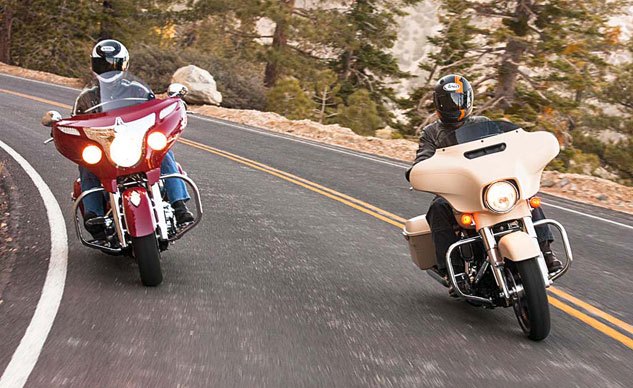
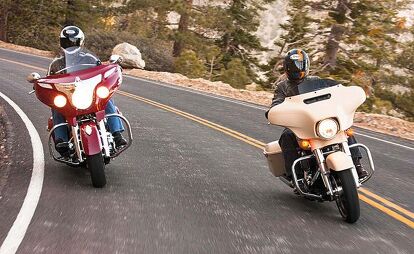







































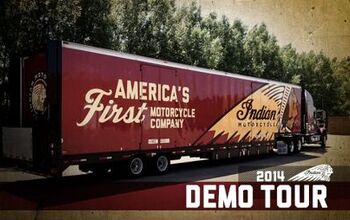
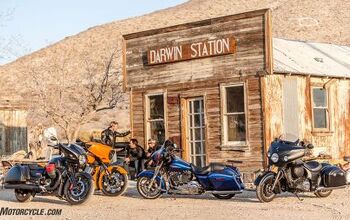








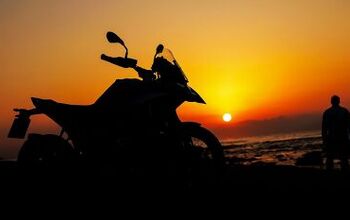






Comments
Join the conversation
Well if Polaris built these bikes in 2 years I can only image what they'll accomplish in the next 2 years. Competition is good don't you all agree.
I currently own a 2014 Street Glide (Aug '13-Present) which I just rode to and from Sturgis from the East Coast, and did multiple side trips while there-total of 4802 miles in just under 3 weeks; last Fall, I traveled up to Buffalo, into Canada, and down through Vermont to catch the peak Fall colors-almost 1800 mile trip on this bike. In total, I have almost 13K miles on my bike. I rode through the winter as well-except snow days. The engine and performance are significantly better than my former 2012 SG (see below)--and no more CDs for music. The change in saddlebag operation a major plus over my '12 SG.
I rode the Indian Chieftain and Roadmaster at Sturgis a few weeks ago. Each bike has its pros/cons, but I can honestly say I prefer my Street Glide over the Chieftain. As for the Roadmaster, the engine through off too much heat, so when compared to the Ultra Limited, I'd buy the Harley. However, in talking to the 2 up rider, they preferred the roominess of the Roadmaster over the Ultra. The adjustable windscreens are a plus, but I am 6'1" and preferred the SG, especially the buffering ('12 SG, I endured it-its gone on my '14 SG)-felt some on the Chieftain.
I don't have any bias, and in fact, I really wanted to own something different, and seriously looked at an Indian. However, I prefer the Harley ride. I liked the TPM on the Indian, but preferred the toggles on the SG. As for sound, the Harley outperforms the Indian.
I would like to see them fix the transmission and the sound when shifting gears-annoying.
I have felt very comfortable on my Street Glide for travel. In 2012, I purchased a Street Glide and rode almost 7K miles x-ctry and back in a month-again, a very comfortable ride. However, my '14 Sg is definitely superior to my former '12.
I am currently eyeing a 2015 CVO Street Glide, but not sure what color scheme---any thoughts on the 4 schemes---which looks the best?
I would get the bigger bike if I had a 2 up passenger--but the Mrs. won't ride, so I stick w/the SG; yes, I had a Classic for 5 months, hoping she'd change her mind. The tour pack comes in handy during long ventures, but w/o it, you still can travel-gotta leave some things behind.
No matter which bike you choose---get out and ride. It's cliche, but do it now, as you never know what you could be battling in the future.This was my first trip for the Sturgis rally-enjoyed it-and I am not a partier. I like to travel and sightsee---but I did enjoy Full Throttle Saloon and their ladies-very attractive young ladies who can shake it, and its entertainment/concerts are free too vs the Chip's cost, which includes camping.